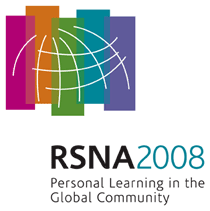
Abstract Archives of the RSNA, 2008
Aliya Qayyum MD, Presenter: Spouse, Employee, Koninklijke Philips Electronics NV
Michelle Nystrom, Abstract Co-Author: Nothing to Disclose
Susan Moyher Noworolski PhD, Abstract Co-Author: Nothing to Disclose
Phili Chu, Abstract Co-Author: Nothing to Disclose
Alireza Ghotb, Abstract Co-Author: Nothing to Disclose
Daniel Blackburn Vigneron PhD, Abstract Co-Author: Nothing to Disclose
To determine the accuracy of steatosis-corrected apparent diffusion coefficient in distinguishing early from advanced fibrosis in nonalcoholic fatty liver disease.
Committee on Human Research approval and patient consent were obtained, and the study was in compliance with the Health Insurance Portability and Accountability Act. Forty-nine subjects, 36 patients with nonalcoholic fatty liver disease and 13 healthy controls (28 men and 21 women) with a mean age of 44 years (range, 11 to 73) underwent MRI including opposed-phase and diffusion imaging of the liver. The 36 patients underwent contemporaneous liver biopsy. Relative liver signal intensity loss and apparent diffusion coefficient (ADC) were correlated with pathology in the 36 patients. ADC was corrected by adding 0.3 x10-3mm2/s for patients with signal intensity loss of >0.3. Spearman’s correlation coefficient was used to determine correlation of ADC thresholds of <1.2, <1.4, and <1.6 with stage >2 fibrosis. Sensitivity, specificity, positive and negative predictive values for detecting moderate to severe fibrosis were determined at selected ADC threshold values.
The number patients with grades 0, 1,2 and 3 steatosis were 16, 8, 12 and 13 and stages 0, 1, 2, 3 and 4 fibrosis were 23, 16, 7, 2 and 1, respectively. The mean liver signal intensity loss was 0.2 (range, -0.11 to 0.71). Spearman’s correlation with stage >2 fibrosis for uncorrected ADC thresholds of <1.2, <1.4 and <1.6 were 0.48, 0.50 and 0.36. Spearman’s correlation with stage >2 fibrosis for corrected ADC thresholds of <1.2, <1.4 and <1.6 were 0.59, 0.57 and 0.34. The accuracy for detecting stage >2 fibrosis with thresholds of <1.2, <1.4 and <1.6 was 85%, 81% and 19%, respectively. A threshold value of <1.2 resulted in a sensitivity, specificity, positive and negative predictive value of 78%, 87%, 58% and 94% for detection of stage >2 fibrosis.
Apparent diffusion coefficient with steatosis correction is highly specific and can accurately distinguish early from moderate to severe fibrosis.
Apparent diffusion coefficient with steatosis correction is highly specific and can accurately distinguish early from moderate to severe fibrosis.
Qayyum, A,
Nystrom, M,
Noworolski, S,
Chu, P,
Ghotb, A,
Vigneron, D,
Staging Liver Fibrosis in Non-alcoholic Fatty Liver Disease: Accuracy of MR Biometrics. Radiological Society of North America 2008 Scientific Assembly and Annual Meeting, February 18 - February 20, 2008 ,Chicago IL.
http://archive.rsna.org/2008/6013118.html

